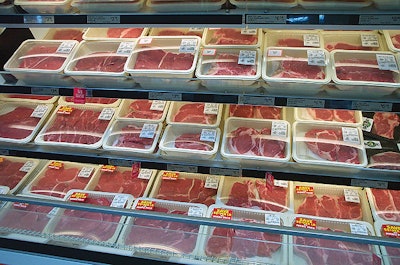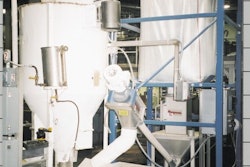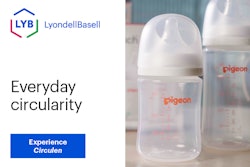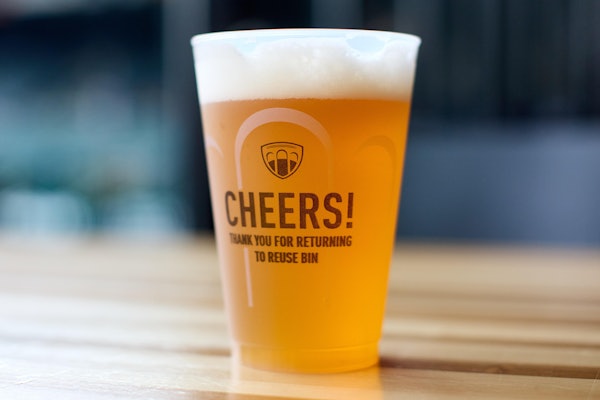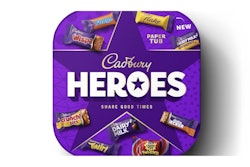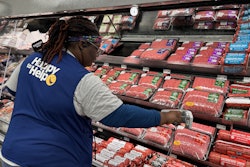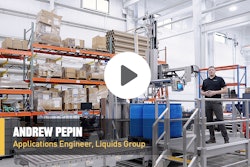Short on in-store labor, long on shelf life, case-ready meat brings advantages to a growing number of stores and chains across America, including Albertson’s, Costco, Kroger, Pathmark, Safeway, Shop-Rite and, last but not least, Wal-Mart...
With deadline pressures looming, I traveled to my hometown of Clinton, a small town in easternmost Iowa. I drove not for escape, but for insight. My destination: A showcase of refrigerated case-ready meat, found at a Wal-Mart Supercenter that opened in mid-2000. The Supercenter all-under-one-roof megastores are said to have an amazing selection of case-ready meat.
It’s hard to dispute that point while gazing upon thirty-some linear feet, four-shelves deep, of the most impressive display of case-ready chicken, pork, lamb, veal, beef, ground beef, and turkey likely found anywhere, with the exception of another Supercenter. At the end of 2002, there were 1곢 Supercenters throughout the United States. This year, one new Supercenter will open somewhere in the U.S., on average, every 42 hours. That’s a growing mountain of case-ready meat.
Chris Simons, group brand manager of case-ready meat for Cargill, Minneapolis, MN, which owns Excel, says “Other retailers have converted part of their case—beef, pork, or grinds—or some stores to case-ready, but Wal-Mart is the only retailer that is 100-percent case-ready.” Cargill operates seven case-ready meat plants that supply product to retailers such as Wal-Mart, Kroger, Shaw’s, and Teeter’s, Simons says.
Wal-Mart would not respond to our inquiries except through a spokesperson who stated: “We have had positive customer reaction regarding our case-ready meat product line. We find that case-ready meat offers a variety of benefits to our customers including enhanced quality control, better overall appearance, and the increased ability to keep products in-stock.”
Just what is case-ready meat? Meat industry veteran Dan Murphy, former editor of Meat Marketing and Technology, and now vice president of public affairs with the American Meat Institute, defines case-ready as “Fresh meat prepackaged and/or prelabeled at a central location.” Packaging ranges from film-sealed trays to pouches, bags, chubs and thermoformed packs using vacuum or other type of modified atmosphere packaging.
Savings lean?
Wal-Mart made its commitment to case-ready three years ago, embracing the labor savings of fresh meats prepared and packaged off premises with the promise of minimal in-store prep work by retailer personnel.
Does it deliver? Well, maybe, according to a 2001 study by Keymark Associates, Marietta, GA, that concluded: “Case-ready cost savings? Maybe, maybe not.” Keymark principal Huston Keith says the economics of case-ready remain questionable: “Retailers find out that it doesn’t eliminate labor.”
Wal-Mart is a case in point. According to Supercenter meat manager Lauren Story, the labor savings aren’t as big as one might think—or as Wal-Mart may have hoped. The retailer doesn’t allow boxes on the store floor, he explains. As a result, workers must unload the sealed trays of meat in the backroom onto carts, wheel the carts to the case, and stack the packages in the display.
The packaging for those case-ready products is not inexpensive. Keymark pegs costs at 30¢ to 80¢ more per pound for case-ready packaging compared to chubs or primal forms.
Arguably lean on cost savings, case-ready fattens up on food safety, including thorough USDA inspections and HACCP controls at processors’ plants.
“There’s still many compelling reasons why retailers want case-ready meat,” says Keith. “It’s not just the economics, the issue of food safety continues to grow. Retailers feel that their liability is lessened by the use of case-ready products.”
Fowl rules
In early 2003, a change in the Supercenter’s warehouse switched the beef supplier to what was formerly IBP, now owned by Tyson Foods, Springdale, AR.
Tyson supplies the Supercenter’s case-ready pork and chicken. The largest section—a 12’ facing four rows high—was dedicated to chicken. That allocation dovetails with a comprehensive in-store study conducted by Cryovac division Sealed Air Corp. (see chart opposite). One of the study’s findings was that the poundage of chicken and turkey in case-ready packaging runs neck and neck at 84% and 86%, respectively, the highest of any species. Wal-Mart’s Story points out that Tyson has gone to a fixed weight, such as 26.4 oz net weight, for its chicken packs rather than random weights as it had used before (see Tyson sidebar, page 71). Crucial information such as a use-by or freeze-by date and pricing is printed by Tyson right on the package film. This eliminates an added label and gives the package a neat appearance.
“Retailers want unit pricing,” observes Murphy, “which drives exacting portion weights for meat packers.” That’s driven Tyson to dedicate one plant—and it is converting another—to fixed-weight packages. It’s the first wave of a major new trend in case-ready packaging.
At a Cub Foods store in Chicago area, rows of Hormel’s Jennie-O Turkey Store brand were merchandised flat. With the two-toned green awning design printed on paperboard inserts and sealed in a clear film overwrap, the tray-packs of ground turkey provide a premium look rarely seen in the meat case. According to Steven Frank, Jennie-O vice president marketing, retail division, the brand’s recent graphics improvements were done to “contemporize the products and maximize the appetite appeal.”
“Turkey brands created a market for ground turkey, and this type of packaging communicates ‘fresh’,” notes Keith, pointing out that the prior packaging consisted of chub packs of frozen turkey that didn’t sell very well.
Says one industry insider: “Retailers want to differentiate their package and their method of merchandising from their competitors.” One example: Euro-inspired styling using clear trays molded of clarified polypropylene. Used by packers like Farmland Foods, Kansas City, MO, for its sliced fresh pork, the trays provide an added dimension to showcase the product since the back of the cut is now visible through the tray bottom.
Beefed up generically
While glitzy packaging always gets attention, generic packaging may get the marketshare, at least for beef. In contrast to the branding equity of chicken, turkey, and pork packaging and a corresponding wash of color-coded packaging, the Supercenter’s beef section has a distinctly generic, yet highly appealing, look. That’s desirable for many cuts of case-ready beef, Wal-Mart’s Story points out. And it’s key to the category’s success here.
The modular sections devoted to cuts of beef are filled with functionally effective packaging. Supplied by the former IBP operations now owned by Tyson, the packaging represents a change in suppliers made earlier this year, Story says. Beige-colored trays offer sparse graphics via pressure-sensitive labels on clear film sealed along the flanges that provides a prominent view of the red meat. The high-oxygen beef packs sold at Wal-Mart are an 80/20 mix of carbon dioxide and oxygen and provide 11 days shelf life, according to sources.
“Just about everyone knows that it’s prepackaged, but the perception with this kind of packaging is that it’s fresh,” says Story. “It’s taken a lot of back and forth with our suppliers to raise the meat-cutting standards closer to how our butchers would have trimmed.” High praise indeed from a former butcher.
A similar approach toward ground beef is found in Melrose Park, IL-based Jewel-Osco stores—part of Albertson’s, the second-largest supermarket chain in the United States—which offer prepacked trays of case-ready ground beef. The displays are located near counters behind which meat cutters prepare and package fresh meat. Along with utilitarian branding via a pressure-sensitive label applied to the clear film, the impression is that of freshly prepared on-site.
Where’s the beef?
Now that pork, chicken, turkey, and ground beef segments have moved significantly into case-ready packaging, AMI’s Murphy calls fresh beef the “final frontier of case-ready meat.” Cryovac’s study notes that beef dramatically trails all others species in case-ready packaging.
Consultant Keith can think of one reason against a national brand of case-ready beef. “It may alienate the retailer who has been marketing for years that his beef is better than the store down the street. Suddenly, everyone has Excel- or Tyson-brand beef and it becomes a pricing game.”
“The benefits of case-ready products are too dramatic to ignore,” says Murphy. “Ultimately, there’s no reason why most retailers wouldn’t adopt a case-ready program for beef under their own brand or a national marketer.”
No matter how it all shakes out, one thing is for sure: Packaging will continue to play a key role across the spectrum of case-ready meat packaging.
“Consumers appreciate upscale packaging,” says Murphy, “and case-ready packs offer greater security, less leakage, and a premium connotation to the product. Case-ready meat is absolutely a growth market.”
See sidebar to this article: Is this package the future of case-ready?
